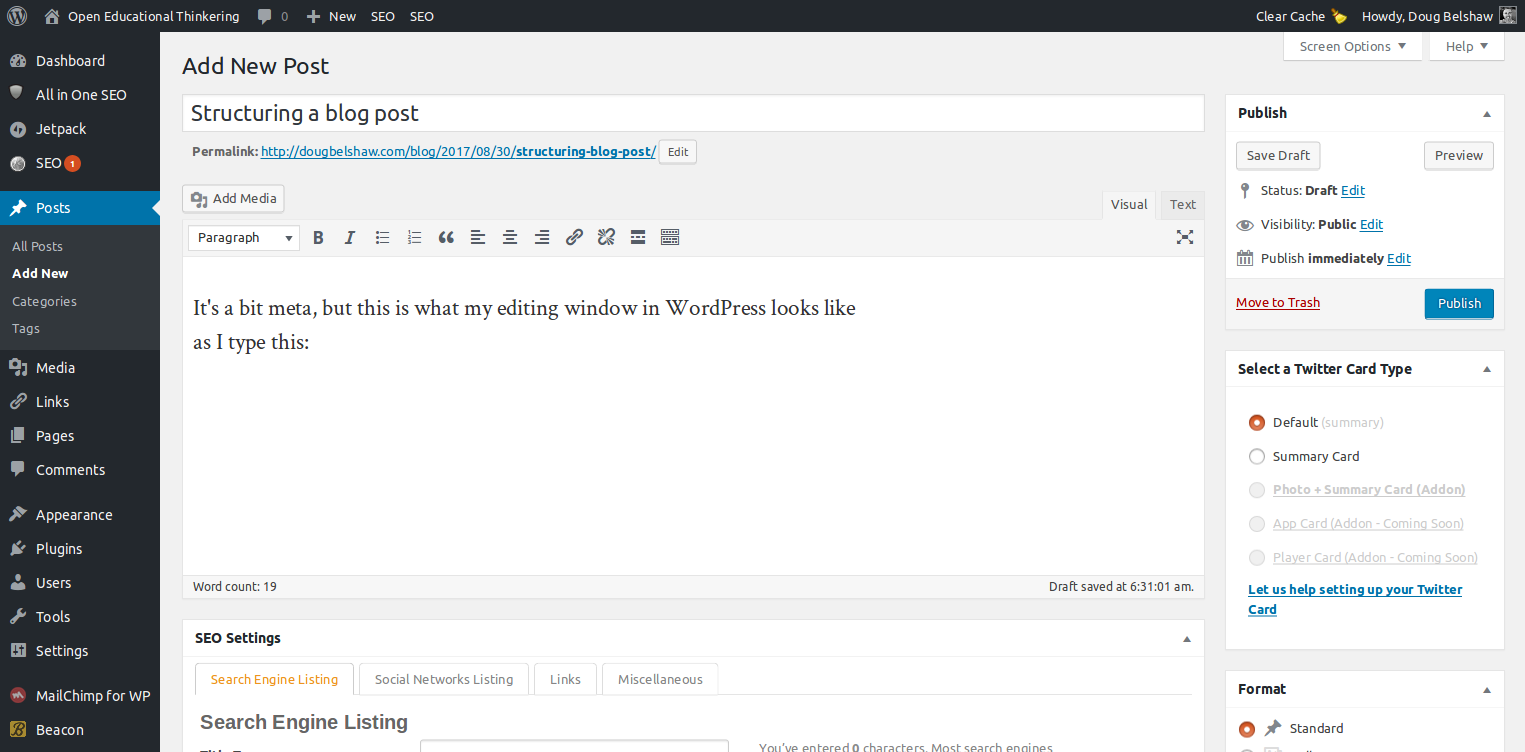Putting your blog post into the world
This is part of a series. In the following, I cover some of the things you should consider as you put your blog post out into the world for others to read. This includes discoverability, commenting, and following-up.
According to one source, over two million blog posts are published each day. Some of these are personal in nature and will be read, and are intended to be read, by a very small audience. Meanwhile, some of these blog posts are written by paid staff and are meant to be read by as wide an audience as possible. The latter is often known as content marketing.
Content marketing means attracting and transforming prospects into customers by creating and sharing valuable free content. The purpose of content marketing is to help the company to create sustainable brand loyalty and provide valuable information to consumers, as well as create willingness to purchase products from the company in the future. This relatively new form of marketing usually does not involve direct sales. Instead, it builds trust and rapport with the audience. (Wikipedia)
You might be reading this and thinking ‘content marketing doesn’t apply to me’. I want to persuade you otherwise. Like it or not, people will use your writing as a way to think about you as a person.
Discoverability
Your blog posts will turn up when people use a search engine to find out more about you. This means that you’re in the game of reputation management. While you’re not neccessarily “attracting and transforming prospects into customers” the whole point of you writing the post is to inform, engage and/or entertain and audience.
Although some people (including me!) still use RSS readers to get updates on news that interest me, most people these days come across things via social networks. Unless you are actually blogging on behalf of a brand, the chances are you won’t have the time, patience, or inclination to post to every possible place where you could promote your work.
Instead, focus in on what you’re trying to achieve, and select the places you’re going to prioritise. For example, I don’t have a Facebook or Instagram account, and have long since given up on Google+. As a result, every time I write a new post, it goes straight away to:
- Social.coop (powered by Mastodon)
- Thought Shrapnel Live!
Then, at the end of the week, I include the posts I’ve written in my weeknotes, as well as in my newsletter.
Although I’ve experimented with auto-posting to social networks, I’ve gone back to doing so manually. Each one has a certain ‘grammar’ to it and, well, it just seems obvious and a bit tone-deaf when people auto-post. It’s best to do it in a more organic way, I’ve found.
Remember that many social networks will auto-preview your blog post with at least the title and image you’ve chosen to accompany it. Make sure these tell the story (and/or give the vibe) of what you’re trying to get across.
Commenting
Mainly as a result of the explosion of social networks over the last decade, I’ve found that it’s become less and less likely that people will leave a comment directly on my posts. Some people use plugins to allow Facebook to power their comments section. Some people do without a comments section altogether. It’s entirely up to you.
What I’d advise is that you should be intentional about the ‘call to action’ (as it’s known) that you provide. If you want people to leave a comment, then say so — and suggest what it might be about. For example: “I’d love your thoughts on whether comments sections are a good or a bad idea”.
Unless you decide to turn off comments, you’re going to want some kind of moderation system in place. Most these days allow you to hold comments by first-time commenters in a queue for you to review. Once they’ve proved they’re not a spam bot or a troll, you can let them post directly to the site.
I know others have had problems with commenting and, while as a straight white male in a developed country I’m speaking from a position of privilege, I’ve never had many problems with comments on the web. If people step out of line, tell them so. It doesn’t happen very often at all.
Most people who read your blog post won’t comment at all. Some who do comment won’t do so on the post itself, but give their thoughts, or frame it as they share it with their networks. Again, make sure the your title is both specific and generic enough to do the work you’re asking of it.
Follow-up
Once you’ve sent your blog post out into the world, don’t just expect it to fend for itself. Support it! Nurture it!
There are multiple ways of doing this. For example, given that most people pay attention to whatever’s in their social network feed at a given moment, you might consider re-posting it a few days later. Again, there a plugins that do this, you can schedule it, or just do it in a spontaneous fashion.
Another way of leveraging the work you’ve put into the post is by citing it in a follow-up post. Use it as a building block. As you’ll no doubt have already seen, this post that you’re reading is part of a series on the same topic. That’s a great way of pointing to an emergent body of work.
Finally, don’t be shy about making people aware of your work. You’ve written your blog post(s) for a reason, for an audience. If you think someone, or someone’s network, would benefit from reading it, then tell them! You can also drop in hashtags or post to particular groups.
Remember with the latter example, however, that an important part of blogging is reciprocity. That doesn’t just go for citing and linking to other people’s work within your post, it also goes for pointing to other people’s work on social networks. You scratch their back, and their more likely to scratch yours…
What have I missed? What would YOU add to this? Let me know in the comments section below, or on Twitter, LinkedIn, or Mastodon!
Photo by WOCinTech Chat used under a Creative Commons Attribution license.




